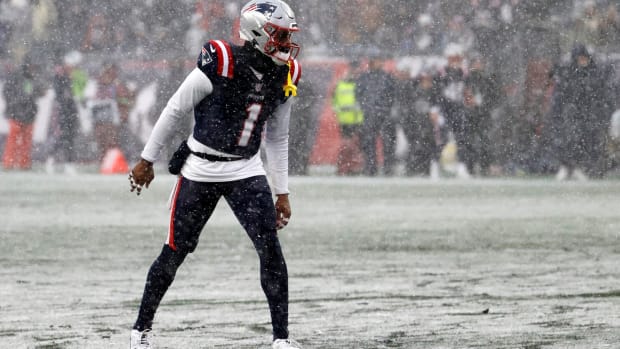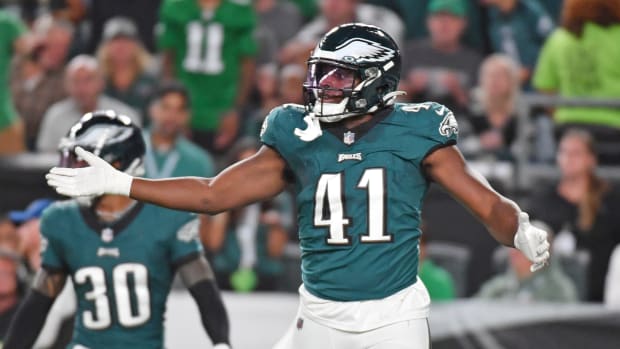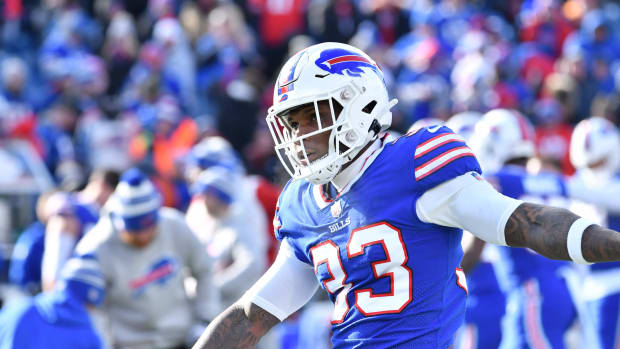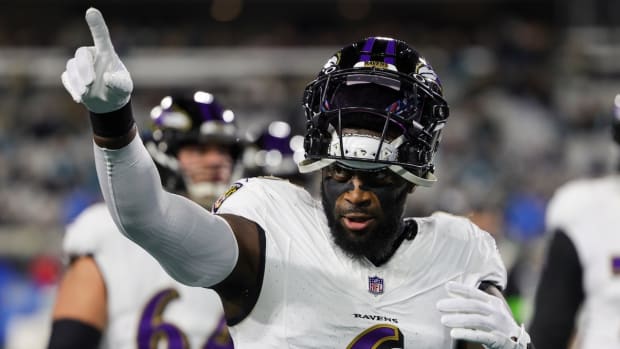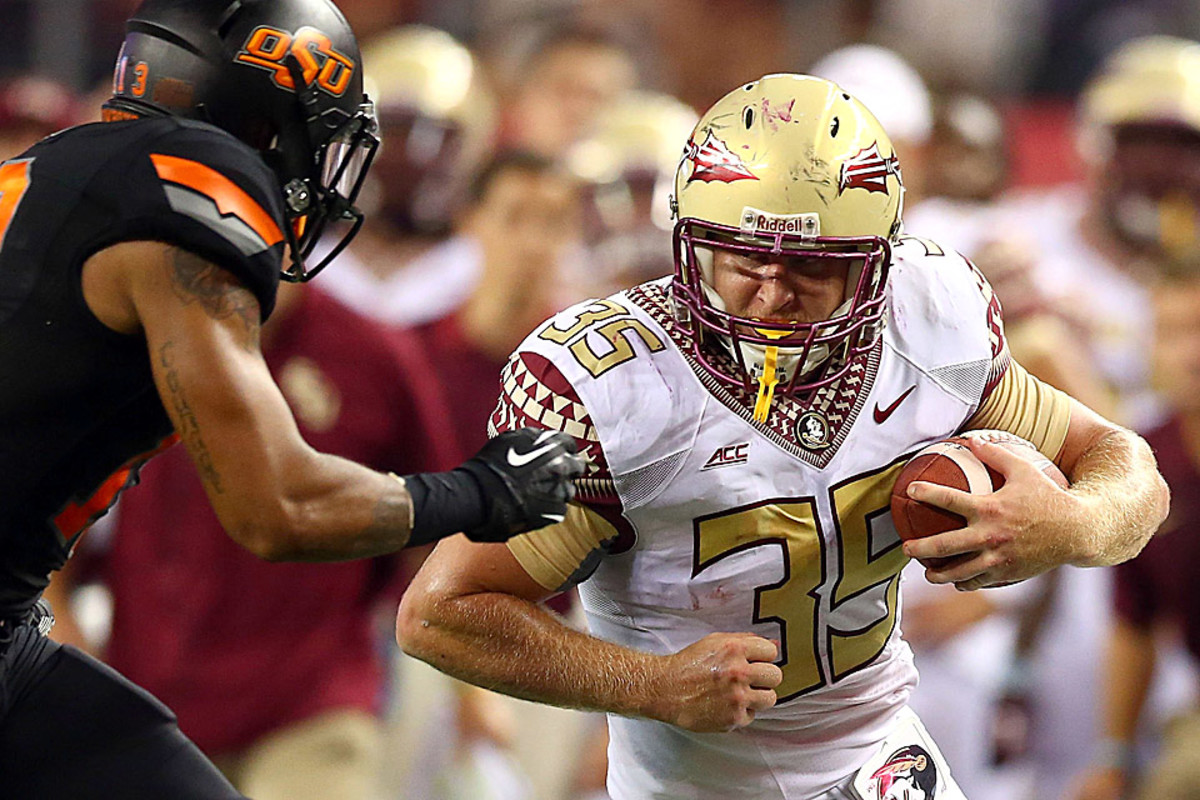
The Throwback
TALLAHASSEE, Fla. — Nick O’Leary had one last route in his warmup, a corner route. Run upfield, turn at a 45-degree angle, catch a floating pass and jog to the locker room until kickoff of the Rose Bowl.
Then it happened—two unmistakable pops in his left hamstring as he came out of his break.
He knew something was wrong. So did the O’Leary-Nicklaus clan, a party of about 25, watching him from the stands. And then there were the tens of thousands of fans in the stadium, the media and soon a national television audience. This was college football’s first national semifinal game—ever. Nothing would go unnoticed.
Thirty minutes before what could be O’Leary’s final collegiate game (it was), the senior tight end wasn’t asking if he’d play. He was asking how. Florida State’s medical staff gave him painkilling shots, and then there was the matter of the Seminoles’ offensive game plan for Oregon, carefully constructed over a month-long lead up.
“That was a game I was going to play outside a lot, as a receiver,” O’Leary says. “It totally screwed everything up. I couldn’t run how I wanted to run. I was blocking more, and they were trying to get me out on some routes where if I could get to that spot, I would be open. But a lot of times I just couldn’t maneuver through everybody to get all the way over there.”
Photo by Todd Rosenberg for The MMQB
Late in the first quarter, O’Leary was blocking on a goal-line run when his left leg gave out underneath him—he couldn’t stay upright (Florida State never got in the end zone on that drive). Overnight, after the 59-20 loss, the injury settled in as a sprawling red-purple bruise, covering most of the area between his buttocks and knee. The diagnosis was a Grade 2 hamstring strain, he says—a partial tear of the muscle. For a week he had trouble sitting because it felt like there was a softball-sized lump in the back of his leg.
“It just wasn’t what I wanted everybody to see me going out as,” he says.
Yet, when Florida State coach Jimbo Fisher sells O’Leary to NFL teams, this game is Exhibit A—not because of how he played on New Year’s Day, but the fact that he played at all. He arrived in Tallahassee four years ago as a curiosity, “Jack Nicklaus’s grandson.” That perception changed over four seasons in garnet and gold. O’Leary became known as a guy who will play through injury, a guy who doesn’t wear gloves, a guy who shows tenacity mixing it up as a blocker. He is of a breed that is virtually extinct in the college game, the kind of draft prospect becoming increasingly scarce in recent years. He is a throwback: an all-around tight end.
* * *
The Prospects
Jean Sifrin: The UMass tight end’s improbable 10-year journey from high school dropout to draft prospect.Leonard Williams: Our Andy Benoit sat down for a film session with the draft’s best defensive player.Brandon Scherff: The draft’s best—and nastiest—blocker is a modern-day Paul Bunyan.Marcus Mariota: The Oregon QB's game is being scrutinized more than any other prospect's.Lynden Trail: The draft's biggest mystery man comes from little Norfolk State.T.J. Clemmings: A switch from defense to offensive tackle awakened a monster.Shaq Thompson: Before he was an NFL prospect, he was baseball’s worst player.
“Nick,” says Jack Daniels, his football coach at Dwyer High, “is as plain as they get. Shoot, I don’t even know if he showers half the time. He walks around barefoot with just a white T-shirt on, and shorts.”
Sure enough, on a warm afternoon in mid-March, O’Leary is sitting in a third-floor conference room at Florida State’s football building, and he hasn’t showered yet after his afternoon workout. When he’s asked about draft weekend—NFL talent evaluators project the John Mackey Award winner (as the nation’s top tight end) to go anywhere between the third and fifth rounds—he gestures around the quiet room.
“I really just want to be, like, in this room by myself,” he says, “with nobody around.”
He’s half-kidding. O’Leary loathes attention. He also has high standards for what warrants it. That’s a consequence of his mother’s maiden name, and his first name: Nicklaus.
Nan O’Leary gave her second son that name as a “quiet tribute” to her parents. Her father is arguably the greatest golfer of all time. Jack Nicklaus and his wife of more than 50 years, Barbara, live within three miles of four of their five children in North Palm Beach, Fla. That includes the O’Learys. Barbara keeps a color-coded calendar listing the sports events of their 22 grandchildren. If there is a conflict, they pick the oldest child’s game, or split duty. In O’Leary’s four seasons at FSU, Jack missed only one game—and that was because two other grandsons were playing in their final high school football game. His son Steve (Nick’s uncle) was a receiver at Florida State in the 1980s and has a skybox at Doak Campbell Stadium, where Nicklaus is usually a quiet observer, his chin often resting on his hands.
Nick O’Leary didn’t grow up watching his grandfather win golf tournaments, but he grew up with the legend. That brought spoils—a family ranch in Okeechobee, trips to South Africa to hunt or to the Bahamas to fish, the private jet “Air Bear” —but also scrutiny. Nan reminded her five children (four boys and a girl, just like her parents had) of the advice her grandmother had once given her: You kids have to put in 200 percent to get 100 percent of the credit.
“I think it took four years at Florida State before we’d go through a game when the commentator didn’t mention who his grandfather was,” Nan O’Leary says. “And obviously, it’s a wonderful thing, and it’s positive. But people used to say, ‘Oh, well he was born with a silver spoon in his mouth.’ Nick is the one out there on the field. My dad is not out there catching. My dad is not out there running. Nick is doing it. That’s probably one of the things that drives me the most crazy.”
During O’Leary’s senior season at Dwyer High, the team traveled to Cleveland for a nationally televised game against Glenville High. At the end of the tight game, Dwyer appeared to score the go-ahead touchdown three separate times—once on a catch in the end zone incorrectly ruled incomplete, twice on goal-line runs that broke the plane—but none of the plays was ruled a score. Dwyer lost. As the team was leaving the field, cameras caught O’Leary, who played 140 snaps on offense, defense and as a punter, flipping his middle finger.
The headlines were predictable: Jack Nicklaus’ grandson caught making obscene gesture. Social media fueled the fire and O’Leary was suspended by the Florida High School Athletic Association for two games. Daniels wanted to forfeit those two games, feeling that O’Leary had been provoked and singled out. But the coach now recounts the situation as an example of the kind of influence Nicklaus has on his grandson.
“We went out to his grandfather’s golf club in Columbus afterwards for dinner,” Daniels says, “and the thing I remember is his grandfather being disappointed that that was the way Nick responded. He let him know that’s not the way you respond to things when things don’t happen the way they are supposed to happen. Just to handle yourself with class, just like his grandfather does all the time.”
O’Leary issued a written apology the next day, which was published by the South Florida Sun-Sentinel. Nicklaus is very close to Nick, who, by the way, says he gets down close to scratch when he has time to golf regularly. Nan calls her dad Nick’s biggest supporter. But as his grandson has climbed toward his own professional career, Nicklaus has been careful not to be out front. He graciously declined The MMQB’s interview request through a spokesman: “While they are both enormously supportive of him they are simply proud grandparents who have been there every step of the way.”
* * *
Photo by Mike Ehrmann/Getty Images
O’Leary has a simple reason for never wearing gloves when he plays: When he was in middle school, he felt it was a waste of time and money to buy something he didn’t really need. He grew up catching footballs without them, so why start now?
One of his closest friends at Dwyer, Curt Maggitt, now a defensive end at Tennessee, remembers an especially cold game (by Florida standards) during their sophomore season. Temperatures were in the 30s, and afterward O’Leary showed him his bare hands, all red and blistered up. “I asked him, ‘Why won’t you wear gloves?’ ” Maggitt says. “Seeing that, I knew, he’s definitely different.”
O’Leary’s hands might be his best attribute—“Best hands of anybody I’ve ever coached,” Daniels says. But O’Leary never bought into that. In his first season at Dwyer he hadn’t dropped a pass all year, but in a game against Okeechobee there were two or three passes thrown his way that he considered drops. His definition: If he can touch it, he should catch it. Saturday morning at 7 a.m., while the coaches were breaking down film, he showed up at the high school asking for one of them to throw balls to him. These early starts weren’t unusual—when he came home from Florida State between semesters, he’d text Daniels to meet him at the high school and keep time for him on conditioning sprints. Twenty 100-yard sprints, each one on the minute, starting at 5 a.m.
O’Leary is also a throwback in the role he played at Florida State. The traditional tight end has become de-emphasized in the college ranks. The advent of spread offenses has led to athletic tight ends serving as essentially big wide receivers. Those who play in-line are usually blockers first and foremost. Few entering the NFL have experience in the way they’ll likely be used in the pros: catching passes and mixing it up as blockers.
“It’s not one of those classes where you have 10 guys at the top of the class that are what we call Y’s and F’s, the versatile guy,” Falcons GM Thomas Dimitroff said during the NFL combine. “But you have a number of good football players that can affect a team’s offense, some as blocking tight ends, and obviously as receiving tight ends.”
Scenes from a Pro Day
Robert Klemko gets a peek behind the curtain of a Pro Day. What goes on? Lots of prying and lots of stopwatches. And, in the case of the University of Maryland, an unusual visit from Bill Belichick. FULL STORY
O’Leary showed that versatility in college. During his senior season he primarily lined up as an in-line tight end (714 snaps). But he also moved around the field: 88 snaps as a slot receiver, 16 in the backfield, even 10 split out wide. He was important as a receiver (“People didn’t realize,” Fisher says, “he had an option on almost every play, for us to go to him”) but was frequently kept in to block. O’Leary ran 398 pass routes as a senior—fourth-most among FBS tight ends—and stayed in to pass-protect or run-block on 430 plays (all statistics per College Football Focus). He caught 48 passes for 618 yards and six touchdowns on the year.
Just as quarterback Jameis Winston’s experience in Florida State’s pro-style offense is viewed as a strength, the same is true for O’Leary. But when he arrived at Florida State, he didn’t realize he’d be expected to block so frequently.
Daniels recalls a few text exchanges during O’Leary’s freshman and sophomore seasons, when he could sense some of his frustration at not being targeted more often. Blocking college defensive ends didn’t come naturally to the 230-pound freshman—a fact O’Leary realized in his first practice when he stared across a blocking pad at a 290-pound defensive lineman. But O’Leary added weight (he’s now at 254) and developed a true willingness to get down and block. His favorite NFL tight end is Jason Witten, because he blocks a lot and catches a lot.
During interviews at the combine, teams typically asked O’Leary to draw up his favorite run and pass plays. For the run, he picked a power, in which his responsibility is to block a defensive end, either on his own or in tandem with the tackle, depending on how many backs are in on the play. For the pass he sketched “cab short wide whip,” a play that calls for him to run a pressure out route and adjust it based on the coverage—sitting it down against cover-2, and running it out against cover-3. This was the play call on his highlight-reel catch against Clemson in 2013, the one on which he separated from a diving defender and later lowered his shoulder to bulldoze a would-be tackler, running up the sideline for a 27-yard catch (he had 161 receiving yards that day).
The most common question O’Leary received, though, had nothing to do with football: “Are you done riding motorcycles?”
Video of O’Leary’s first motorcycle accident, in May 2013, went viral. He was riding in Tallahassee at the end of the spring semester, heading back to the apartment he shared with his brother, when a black Lexus pulled out into the street. He remembers all of what happened next: He swerved to see if he could split between the car and an adjacent bus, but he couldn’t. He aimed for the car’s front tire and flew over the front of his motorcycle.
[youtube https://www.youtube.com/watch?v=OjN90iHtXcI?rel=0]
What’s not on video is him flying the length of the bus, about 100 feet, through the air. He somersaulted upon landing, breaking his left shoulder in the fall. His left leg hit the bumper of a van. Then he got up and walked to the curb. Somehow, he spent only four hours in the hospital.
The second crash, less than a year later, was more concerning. Not because of the severity—the road rash was worse, but the injuries weren’t—but because it happened again. He had to sit out the last few weeks of spring practice before his senior season. The fact that his teenage hobby (he used to pop wheelies down the road at the family ranch) finally threatened his football career may have woken him up, Fisher says.
O’Leary hasn’t sworn off motorcycles forever—though his mom would prefer that he did—but he told NFL teams he has sworn off them for the rest of his football career. After his second accident, he says, he hasn’t been on one since.
* * *
Floridau2019s Dante Fowler
Fowler's lengthy Q&A with Jenny Vrentas. The Florida product says he’s the top defensive prospect of 2015 and would love to land in Atlanta. He wore a gold watch during his combine workout; wait until you see him on draft night. FULL STORY
Two weeks ago, O’Leary was running routes with Winston in Tallahassee, preparing for Florida State’s pro day, when he felt that dreaded twinge in his left hamstring again.
Navigating the months before the draft with a partial hamstring tear has been an obstacle course. O’Leary had to pull out of the Senior Bowl, and during the seven weeks between the Rose Bowl and the combine he spent an hour or two every day in a hyperbaric oxygen chamber. He was able to run and perform in position drills at the combine, but the footnote to his 4.93-second 40-yard dash is his injured hamstring—and the fact that it prevented him from doing his first practice run until the Monday before the combine.
Tight ends with breakaway speed are expected to run in the 4.6 range, and the average for the position is usually between 4.75 and 4.80. That 4.93 fed into teams’ concerns that O’Leary is middling athletically. O’Leary planned to run again at the Seminoles’ pro day, as well as highlight his route-running abilities with Winston. He was arguably the 2013 Heisman winner’s most trusted target over the past two seasons. During crucial situations last year, Winston would tell O’Leary, “You need to get open on this play.”
His hamstring, though, intervened again. He felt the tweak Thursday before pro day, and made the decision the night before not to run. Last Tuesday, the Florida State fieldhouse was packed with coaches and scouts in town for Winston’s scripted workout, and O’Leary had to watch from the sidelines.
Since then, he has spent hours hooked up to an ARP machine, an advanced stimulation device that uses high-frequency currents to break up scar tissue and increase blood flow to the injury site. He wants to be ready for the half-dozen teams that have invited him for private workouts—including one scheduled today with Tampa Bay, the likely destination of his college quarterback. He has scheduled an individual pro day for April 17.
But, O’Leary says, “I think my college film will do its talking.”
What stands out on that film, according to one NFL offensive coach who has watched O’Leary, is “you see that he’s open a lot.” That reflects on what Fisher calls a different kind of speed—the ability to read the field quickly. It’s an innate understanding of football and where the open spaces on the field are going to be, then maneuvering to them.
For his entire football career he has had a simple goal: “I want to be known for me.” There aren’t many tight end prospects like him anymore. Nick O’Leary is his own man.
Follow The MMQB on Facebook, Twitter and Instagram.
[widget widget_name="SI Newsletter Widget”]













































